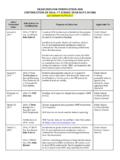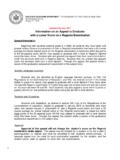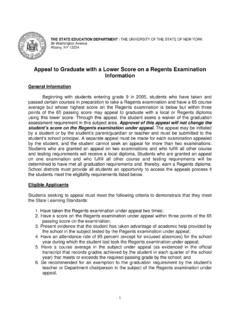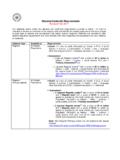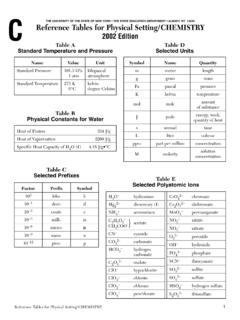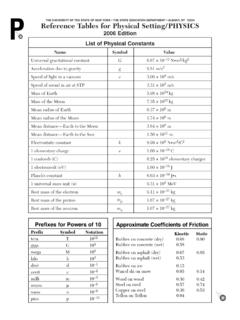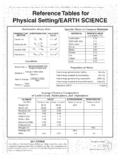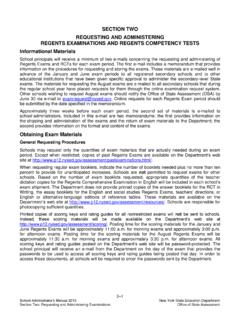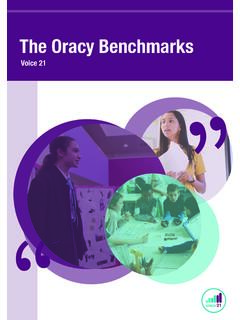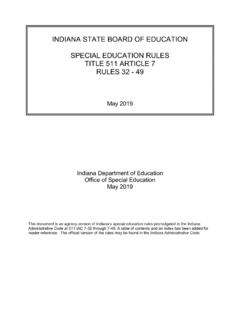Transcription of NYS Social Emotional Learning Benchmarks
1 August 2018 NEW YORK STATE Social Emotional Learning Benchmarks Research suggests that student Learning Benchmarks (or standards) may increase the likelihood that students will receive better instruction in Social Emotional Learning (SEL), experience improved school connectedness, and become better learners (Osher & Kendziora, 2008 and Jones & Bouffard, 2012). To enable students to take full advantage of educational opportunities throughout their school experience in grades K-12 and, equally important, to prepare them for college and/or career, the School Climate and Student Engagement Workgroup of the New York State Safe Schools Task Force have identified the following goals to guide SEL Benchmarks for New York State schools: 1. Develop self-awareness and self-management skills essential to success in school and in life.
2 2. Use Social awareness and interpersonal skills to establish and maintain positive relationships. 3. Demonstrate ethical decision-making skills and responsible behaviors in personal, school, and community contexts. In the following pages, these goals are further explained, with associated Benchmarks provided for voluntary use at the early elementary (K-3), late elementary (4-5), middle school (6-8), early high school (9-10), and late high school (11-12) levels. 2 | P a g e Goal 1: Develop self-awareness and self-management skills essential to success in school and in life. Knowing one s emotions, how to manage them, and ways to express them constructively are essential life skills. These skills enable one to handle stress, control impulses, and motivate oneself to persevere when faced with personal, academic, or work-related obstacles.
3 A related set of skills involves accurately assessing one s abilities and interests, building upon strengths, making effective use of family, school, and community supports and resources. Finally, it is critical for an individual to be able to establish and monitor one s own progress toward achieving goals, whether personal, academic, and career or work-related. These Social Emotional skills, thought processes and behavioral strategies can be contributing factors to one s sense of self-confidence and sense of optimism as they provide a strong foundation for achieving success in school and in life. Grade Level Early Elementary (K-3) Late Elementary (4-5) Middle School (6-8) Early HS (9-10) Late HS (11-12) A. Identify and manage one s emotions and behavior. Recognize and describe emotions and how they are linked to behavior.
4 Demonstrate control of impulsive behavior. Describe a range of emotions and the situations that cause them. Describe and demonstrate ways to express emotions in a constructive manner. Demonstrate control of behaviors that interfere with time on task. Analyze factors that create stress or motivate successful performance. Apply strategies to manage stress and to motivate oneself to constructively address challenges. Demonstrate the capacity to maintain concentration on a task. Analyze how thoughts and emotions affect decision making and responsible behavior. Generate ways to develop more positive attitudes. Demonstrate the capacity to shift one s focus between tasks and maintain concentration on one s goal. Evaluate how expressing one s emotions in different situations affects others. Evaluate how expressing more positive attitudes influences others.
5 Demonstrate the ability to adjust one s behavior in response to changes in one s environment or to changes in one s goal(s). 3 | P a g e Grade Level Early Elementary (K-3) Late Elementary (4-5) Middle School (6-8) Early HS (9-10) Late HS (11-12) B. Recognize personal qualities and external supports. Describe one s likes, dislikes, needs, wants, strengths, challenges, and opinions. Identify family, peer, school, and community strengths and supports. Describe personal strengths/skills and interests that one wants to develop. Explain how family members, peers, school personnel, and community members can support responsible behavior and school success. Analyze how personal strengths and areas in need of improvement influence choices and outcomes. Analyze how making use of school and community supports and opportunities can help one surmount challenges and contribute to achievement in school and in life.
6 Set priorities that build on strengths and identify areas for improvement. Analyze how positive adult role models and support systems contribute to personal growth and achievement in school and in life. Implement a plan to build on a personal strength, meet a personal need, or address a personal challenge. Implement a plan to build on a personal strength to meet a need, or address a challenge facing one s community. Evaluate how developing interests and giving back /filling useful roles support school and life success. C. Demonstrate skills related to achieving personal and academic goals. Describe why Learning is important in helping students achieve personal goals. Identify goals for personal behavior progress, achievement, or success. Describe the steps in setting and working toward goal achievement.
7 Monitor progress on achieving a short-term personal goal. Set a short-term goal and develop a plan for achieving it. Analyze why one achieved or did not achieve a goal. Identify strategies to make use of resources to overcome obstacles to achieve goals. Apply strategies to overcome obstacles to goal achievement. Set a post-secondary goal with action steps, timeframes, and criteria for evaluating achievement. Monitor progress toward achieving a goal and evaluate one s performance against criteria. 4 | P a g e Goal 2: Use Social awareness and interpersonal skills to establish and maintain positive relationships. The ability to recognize the thoughts, feelings, and perspectives of other individuals, including ideas and viewpoints that are different from one s own, and to empathize with others from diverse backgrounds, is central to forming and maintaining positive relationships at all life stages.
8 Equally important to establishing positive peer, family, and work relationships are strategies and skills that enable one to adapt one s behavior in various settings, cooperate and collaborate with another person or in a group, communicate respectfully, and constructively resolve conflicts with others. Grade Level Early Elementary (K-3) Late Elementary (4-5) Middle School (6-8) Early HS (9-10) Late HS (11-12) A. Recognize the feelings and perspectives of others. Recognize that others may experience situations differently from oneself. Use listening skills to identify the feelings and perspectives of others. Identify verbal, physical, and situational cues that indicate how others may feel. Describe the expressed feelings and perspectives of others. Hypothesize others feelings and perspectives in a variety of situations and explain the reasons for one s conjecture.
9 Analyze how one s behavior may affect others. Analyze similarities and differences between one s own and others perspectives. Use communication skills to gain understanding of others feelings and perspectives. Demonstrate how to express understanding of those who hold different opinions. Demonstrate ways to express empathy for others. B. Recognize individual and group similarities and differences. Describe the ways that people are similar and different. Describe positive qualities in others. Identify differences among, and contributions of, various Social and cultural groups. Demonstrate how to interact positively with those who are different from oneself. Explain how individual, Social , and cultural differences may increase vulnerability to bullying and identify ways to address it. Analyze the effects of taking action to oppose bullying and/or bias based behavior based on individual and group differences.
10 Analyze the origins and negative effects of stereotyping and prejudice. Demonstrate respect for individuals from different Social and cultural groups. Evaluate strategies for being respectful of others and opposing stereotyping and prejudice. Evaluate how advocacy for the well-being and rights of others contributes to the common good. 5 | P a g e Grade Level Early Elementary (K-3) Late Elementary (4-5) Middle School (6-8) Early HS (9-10) Late HS (11-12) C: Use communication and Social skills to interact effectively with others. Identify ways to work and play well with others. Demonstrate adaptability and appropriate Social behavior at school. Describe approaches for making and keeping friends. Analyze ways to work effectively in groups. Analyze ways to establish positive relationships with others.

